
Shad Thames is a historic riverside street next to Tower Bridge in Bermondsey, London, England, and is also an informal name for the surrounding area. In the 19th century, the area included the largest warehouse complex in London.

Shad Thames is a historic riverside street next to Tower Bridge in Bermondsey, London, England, and is also an informal name for the surrounding area. In the 19th century, the area included the largest warehouse complex in London.
The street Shad Thames has Tower Bridge at its west end and runs along the south side of the River Thames, set back behind a row of converted warehouses; it then takes a 90-degree turn south along St Saviour's Dock. The street is partly cobbled. The nearest stations are Tower Hill, Tower Gateway (both requiring a river crossing to access), Bermondsey and London Bridge.

The street Shad Thames is named as such in John Rocque's 1747 map of London. [1] The name may be a corruption of 'St John-at-Thames', a reference to the St John's Church which once stood south-west of the street, where the present-day London City Mission is located [2] Alternatively it may be from shad fish, which could be found in the Thames.
The surrounding area is also today called Shad Thames, or Butler's Wharf (after the largest of the riverside warehouses). Both names refer to a 350 m × 250 m (1,148 ft × 820 ft) rectangle of streets, converted warehouses and newer buildings, bounded by the Thames, Tower Bridge Road, Tooley Street and St Saviour's Dock (or arguably Mill Street); it forms the most north-easterly corner of the SE1 postcode district.
The "Woodcut" map of London of c.1561 calls the general area "Horssey Down". [1] The 1872 Ordnance Survey 1:2500 map calls it "St John Horselydown", meaning the parish of St John's Church in Horselydown, though this area extended somewhat further south and west than the modern-day Shad Thames. As it was originally a large field for grazing horses and cattle, it may be a corruption of 'Horse Down'. [2]
In Victorian times, Shad Thames included the largest warehouse complex in London. Completed in 1873, the warehouses housed huge quantities of tea, coffee, spices and other commodities, which were unloaded and loaded onto river boats. For this reason, the area became known as the 'larder of London'. [3] An 1878 book says:
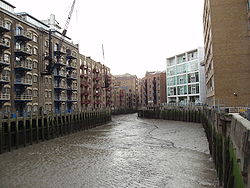
During the 20th century, the area went into decline as congestion and containerization forced shipping to unload goods further east, and the last warehouses closed in 1972.
Many artists lived in the area in the 1970s (presumably owing to the low cost of living there); these reportedly included David Hockney and Derek Jarman.
Shad Thames was regenerated in the 1980s and 1990s, when the disused but picturesque warehouses throughout the area were converted into expensive flats, many with restaurants, bars, shops, etc. on the ground floor.
As part of the regeneration of the area, designer and restaurateur Terence Conran opened a number of now well-known riverside restaurants, including Le Pont de la Tour, the Blueprint Cafe and the Butler's Wharf Chop House. The area also includes numerous cafes, bars, shops and estate agents.
Public access to the riverside was obtained by local community activists including Maggie Blake, after whom an alley leading from Shad Thames to the riverfront, Maggie Blake's Cause, is named. [4]
Terence Conran was also involved in founding the Design Museum near the east end of Shad Thames, which housed exhibitions of graphic and product design; however, the museum relocated to Kensington in 2016 to a larger building formerly occupied by the Commonwealth Institute. The former Design Museum was largely empty as of April 2017 and was expected to be converted into luxury apartments.
The presence nearby of Tower Bridge, the Tower of London, Potters Fields Park, More London (where various cultural events take place) and The Shard means that this once-overlooked area is now frequented by tourists.
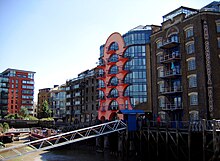
Shad Thames has many residents, particularly living in converted warehouses, and development of new flats continues. They are represented by the Shad Thames Residents’ Association. The converted warehouses retain their original characteristic features of brickwork, winches, large sign-writing and so on, and most are named after the commodities which were originally stored in them – Vanilla & Sesame Court, Cayenne Court, Wheat Wharf, Tea Trade Wharf, with further buildings named after cinnamon, cardamom, fennel, caraway, ginger, cumin, tamarind, clove, anise and coriander. It is said that a century of spices had infused into the brickwork, so after they were converted into flats the first residents of each building could still detect the scent after which it was named. Various new buildings have been constructed, with similarly evocative names, such as Spice Quay Heights and China Wharf.
Shad Thames's proximity to the City of London, which is about a mile north-west on the other side of the river, means that many residents are wealthy City workers, and the restaurants are frequented by City folk at lunchtime. Consequently, local property prices are very high. Properties with river views are particularly expensive, having balconies and dramatic views of the Thames, Wapping (across the river), Tower Bridge, the "Gherkin", and even the distant Canary Wharf, though flats nearer the bridge also command a view of the grey concrete Guoman Hotel (formerly known as the Tower Hotel) on the north side of the river, considered by many to be an eyesore. Most of the warehouses retain the original relatively small windows, which limit their views; some of the newer buildings have better views—for example, flats on the east end of Spice Quay Heights have wide floor-to-ceiling windows on two sides. One of the student residences of the London School of Economics is located on Gainsford Street in the centre of the area.
Among the most striking features of Shad Thames are the walkways which criss-cross the street high overhead. Most of them now connect the Butlers Wharf building and the Cardamom Building and were originally used as bridges to roll barrels and the like between warehouses. They are now used as balconies by the adjoining flats. Photographs from the early 20th century show that at the peak of warehouse usage there were many more of these bridges than survive today.

There is a wide variety of river-going traffic next to Shad Thames. It is part of the particularly deep section of river called the Pool of London, which even ships can navigate. Hence, from time to time even full-size cruise ships or naval vessels will stop next to Shad Thames, usually for a day or so, often then proceeding through Tower Bridge (though they can go no further than the next crossing, London Bridge). Police boats and speedboats pass by frequently, as do passenger boats (such as the Damien Hirst-decorated 'Tate to Tate' boat[ citation needed ]), and yachts from St Katharine Docks on the north side of the river opposite Shad Thames.
Owing to its buildings, cobbled streets, riverside views and proximity to landmarks such as Tower Bridge, Shad Thames has been used as a location for many films and TV programmes, including:
An instrumental track called "Shad Thames" appears on the 1997 Saint Etienne album Continental and 2001 compilation Smash the System .

Bermondsey is a district in southeast London, part of the London Borough of Southwark, England, 2.5 miles (4.0 km) southeast of Charing Cross. To the west of Bermondsey lies Southwark, to the east Rotherhithe and Deptford, to the south Walworth and Peckham, and to the north is Wapping across the River Thames. It lies within the historic county boundaries of Surrey. During the Industrial Revolution Bermondsey became a centre for manufacturing, particularly in relation to tanning. More recently it has experienced regeneration including warehouse conversions to flats and the provision of new transport links.
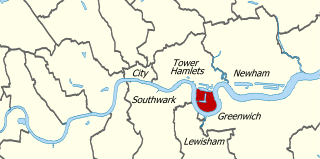
The Isle of Dogs is a large peninsula bounded on three sides by a large meander in the River Thames in East London, England, which includes the Cubitt Town, Millwall and Canary Wharf districts. The area was historically part of the Manor, Hamlet, Parish and, for a time, the wider borough of Poplar. The name had no official status until the 1987 creation of the Isle of Dogs Neighbourhood by Tower Hamlets London Borough Council. It has been known locally as simply "the Island" since the 19th century.
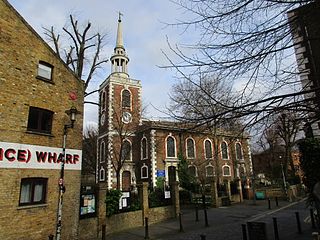
Rotherhithe is a district of south-east London, England, and part of the London Borough of Southwark. It is on a peninsula on the south bank of the Thames, facing Wapping, Shadwell and Limehouse on the north bank, with the Isle of Dogs to the east. It borders Bermondsey to the west and Deptford to the south-east. The district is a part of the Docklands area.

Wapping is a district in East London in the London Borough of Tower Hamlets. Wapping's position, on the north bank of the River Thames, has given it a strong maritime character, which it retains through its riverside public houses and steps, such as the Prospect of Whitby and Wapping Stairs. It also has a Royal Navy shore establishment base on the riverfront called HMS President and home to Tobacco Dock and King Edward Memorial Park.
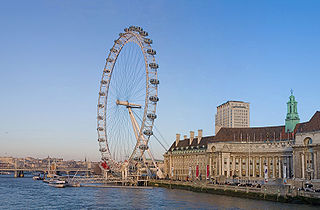
The South Bank is an entertainment and commercial district in central London, England on the south bank of the River Thames opposite the City of Westminster. It forms a narrow strip of riverside land within the London Borough of Lambeth and the London Borough of Southwark,. As such, the South Bank may be regarded as somewhat akin to the riverside part of an area known previously as Lambeth Marsh and North Lambeth.

St Katharine Docks is a former dock and now a mixed-used district in Central London, in the London Borough of Tower Hamlets and within the East End. It lies on the north bank of the River Thames, immediately downstream of the Tower of London and Tower Bridge. From 1828 to 1968, it was one of the commercial docks that made up the Port of London. It is in the redevelopment zone known as Docklands and is now a popular housing and leisure complex.

Blackwall is an area of Poplar, in the London Borough of Tower Hamlets, East London. The neighbourhood includes Leamouth and the Coldharbour conservation area.
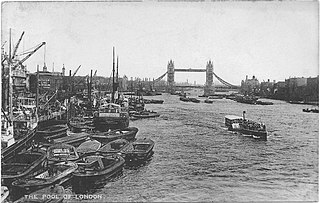
The Pool of London is a stretch of the River Thames from London Bridge to below Limehouse.

Narrow Street is a narrow road running parallel to the River Thames through the Limehouse area of east London, England. It used to be much narrower, and is the oldest part of Limehouse, with many buildings originating from the eighteenth century.

The River Neckinger is a reduced subterranean river that rises in Southwark and flows approximately 2.5 kilometres through that part of London to St Saviour's Dock where it enters the Thames. What remains of the river is enclosed and runs underground and most of its narrow catchment has been diverted into other combined and surface water sewers, flowing into the Southern Outfall Sewer and the Thames respectively.

Butler's Wharf is an English historic building at Shad Thames on the south bank of the River Thames, just east of London's Tower Bridge, now housing luxury flats and restaurants. Lying between Shad Thames and the Thames Path, it overlooks both the bridge and St Katharine Docks on the north side of the river. Butler's Wharf is also used as a term for the surrounding area. It is a Grade II listed building.
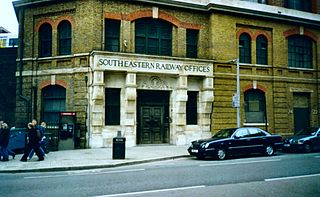
Tooley Street is a road in central and south London connecting London Bridge to St Saviour's Dock; it runs past Tower Bridge on the Southwark/Bermondsey side of the River Thames, and forms part of the A200 road.

The Anchor Brewhouse was a small brewery by Shad Thames in Horsleydown, near Tower Bridge in London. The brewhouse was bought in December 1787 by John Courage. In 1955, the Courage Brewery merged with the nearby Anchor Brewery, then owned by Barclay, Perkins & Co Ltd, to become Courage, Barclay & Co Ltd.

Hay's Galleria is a mixed use building in the London Borough of Southwark situated on the south bank of the River Thames featuring offices, restaurants, shops, and flats. Originally a warehouse and associated wharf for the port of London, it was redeveloped in the 1980s. It is a Grade II listed structure.
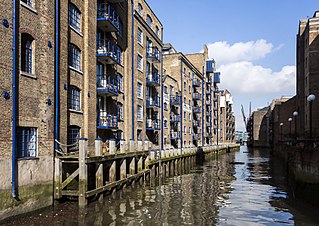
St Saviour's Dock is an inlet-style dock in London, England, on the south bank of the River Thames, 420 metres east of Tower Bridge. It forms the eastern end of the Shad Thames embankment that starts at Tower Bridge. The east side of the Dock is Jacob's Island.

Queenhithe is a small and ancient ward of the City of London, situated by the River Thames and to the south of St. Paul's Cathedral. The Millennium Bridge crosses into the City at Queenhithe.
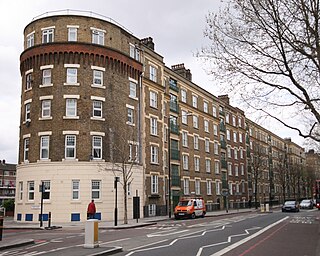
Devon Mansions are a set of five residential mansion block buildings situated along the south side of Tooley Street in Bermondsey, London. The buildings are located within the London Borough of Southwark and are included in both the Tower Bridge and Tooley Street Conservation Areas.

St George Wharf is a riverside development in Vauxhall, Lambeth, London, England, located on the southern bank of the River Thames beside Vauxhall Bridge. Vauxhall Pier is a calling point for Uber Boat by Thames Clippers riverboats RB1, RB2 and RB6 services.
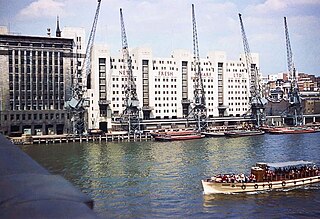
Fresh Wharf was a wharf located in the City of London close to London Bridge, on the north bank of the River Thames. The site was used as a quay in Roman times and later as an unloading place for Anglo-Saxon boats. A wharf was constructed there at some point in the medieval period and appears to have acquired its name from its customary usage as a landing place for fresh fish. In the 16th century, Fresh Wharf was made a "Legal Quay" authorised for the import of certain goods during the reign of Queen Elizabeth I of England. It expanded as London's river-borne trade grew in the 18th and 19th centuries, with large warehouses being established immediately behind the wharf. In the 20th century, the wharf's owners took over the adjoining wharves immediately upstream and downstream, built a new ten-storey warehouse and renamed the site New Fresh Wharf. By the end of the 1960s, however, London's docks had fallen into disuse with the advent of containerization, for which they were not suited, and the wharf was closed down in 1970. An office block was built on the site of the warehouse in 1977 and the former quayside is now part of a public footpath along the Thames.
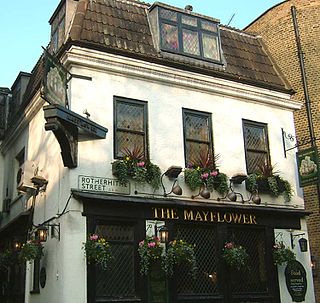
Rotherhithe Street is a road in the London Borough of Southwark on the Thames Path. At a length of around 1.5 miles (2.4 km), it is the longest street in London. Notable buildings on the street include the Grade II* listed Nelson House, St Mary's Church, Rotherhithe and Surrey Docks Farm.
{{cite web}}: CS1 maint: archived copy as title (link)